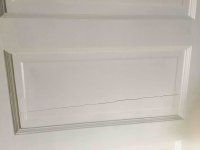I hope this is okay to ask. While I can manage this, I thought "why not ask the experts?" since so many of you are pros.
Our house has a number of 130 year old interior 5 panel doors where one or two of the panels have cracked. See the pic below please - crack is visible on both sides on most doors.
What is the best way to repair these? A friend told me about a trick where you stuff the crack with string, then putty it up. That sounds pretty clever, but what's the best product to use? not the string Or what would you do?
Or what would you do?
From the pic it looks like someone tried to fix something and failed. Also, it seems only the doors leading to poorly insulated rooms are cracked. Working on that too...
[attachimg=1]

Our house has a number of 130 year old interior 5 panel doors where one or two of the panels have cracked. See the pic below please - crack is visible on both sides on most doors.
What is the best way to repair these? A friend told me about a trick where you stuff the crack with string, then putty it up. That sounds pretty clever, but what's the best product to use? not the string
From the pic it looks like someone tried to fix something and failed. Also, it seems only the doors leading to poorly insulated rooms are cracked. Working on that too...
[attachimg=1]

